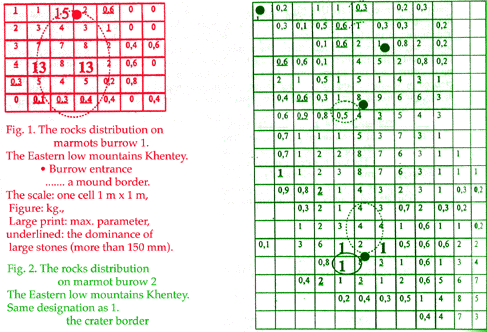All marmots are well known due to their powerful burrowing activity. Their burrow site (region) contrast rapidly to neighbouring landscape. We determine this site as a part of biogeocenosis, as zoophytochora (Guricheva, Dmitriev, 1977, 1983). It has all attributes of biogeocenosis, abiotic and biotic.This place of burrow has specific nanorelief, definite volume of mother rock, weathering bedrock and soil (zoopedon; Dmitriev, Khudyakov, Lim, 1981), ecological regime (water, airial, temperature, etc.), plant and animal societies.
Almost none of those components are well investigated. One of the most interesting questions of marmots geoecology is the relationships of mammals with rocks and rocks layers. The animals of many marmots species are known to prefer rocky places for burrows building. The rocks insure good drainage. The quantity of lifted rocks may be different. On the rocky states we saw a hills of rocks on the marmots mounds, that may be counted as some tons. The rocks amount is depended of rocks quantity in soil and of the age of marmots burrow. We suppose, that the amount of rocks may indicate the burrow age.
We study two marmots burrows on Earst low mountains of Khentey (Mongolia). They disposed on deluvian-accumulative layers on the low part of not high hill (slope 3-7 ). The first burrow was young (Dmitriev, 1982) with only one entrance and one mound. The rocks weighed 106kg 890g, desposed on the square 28m2. The main quantity of rocks is just near the entrance of the burrow, and the largest stones (more then 150mm and 100mm) are fetched down (fig. 1). The relative age of second burrow was middle, the relief was simple. Yhere are 4 entrances, the square of the main mound was about 80 m2, the square with rocks was 192m2. Some single rocks was meeted at 6-8m farther.It was collected 395kg 130g of stones. The distribution was the following (fig. 2)
It is concluded, that the relative age of the second burrow is older (about 4 times) than the first burrow. But the absolute age of the second burrow is older considerably: the rocks on the second burrow are smaller and they are fetched farther. The structure of these burrows seemes may be determined too upon the quantity of rocks lifted to the surface. The rocks lifted from the burrow depth are one share of zoological weathering (Dmitriev, Schauer, 1987) and the creation of rock coat on daily surface.
The other share of zoological weathering is the intensification of physical and chemical weathering in the burrows space. Consequently the specific crater is formed in eluvium and eluvium-deluvium (granite, syenite, aleurolite, sandstone). It may be just filled with rock waste or even new soil. So the marmots digging activity result hard destroyment of rocky layers.

Back to Abstracts contents